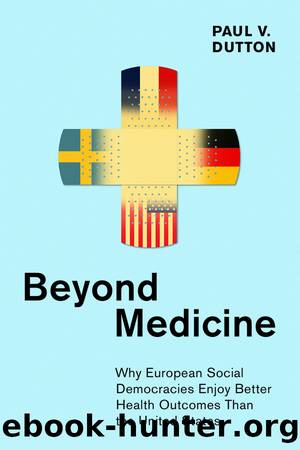Beyond Medicine: Why European Social Democracies Enjoy Better Health Outcomes Than the United States by Paul V. Dutton

Author:Paul V. Dutton [Dutton, Paul V.]
Language: eng
Format: epub
Tags: Medical, Public Health, Health Policy, Political Science, Public Policy, Social Policy
ISBN: 9781501754586
Google: sQrrDwAAQBAJ
Publisher: Cornell
Published: 2021-04-15T13:59:46+00:00
3
After Work in the United States and Sweden
The Swedes themselves are not entirely sure what they have done right.
âPaul Krugman, The Great Unraveling
Uppsala, Sweden. I wake in an unfamiliar bedroom, flooded with sunlight. I had arrived from Paris in the wee hours, and my friend had insisted that I would be more comfortable lodging at her grandmotherâs house than at her own small apartment. Chatting voices now emanate from downstairs although I was told that Grandma lived alone. I dress and descend the stairs to meet her. She is eighty years old, slim, and sharp of mind but unsteady on her feet. Attending to her breakfast and daily medicines is a nurse whom I learn comes regularly to help with the various activities of daily living, such as dressing, laundry, meals, and bathing. She also provides preventive and routine health care. These nursing services are administered by the city of Uppsala, Swedenâs fourth-largest. Local governments are the principal providers for the nationâs elderly. In-home care that allows Grandma to age in place is universally available in Sweden, a major factor in the nationâs rank as the third-best country in the world in which to grow old according the Global AgeWatch Index.
The Global Age Watch employs four criteria to rank the well-being of those over sixty years of age in ninety-six countries: 1) health outcomes, including total life expectancy and healthy life expectancy at age sixty; 2) income security, including pension coverage, the old-age poverty rate, and measures of income and consumption of elderly people relative to the rest of the population; 3) capability, including the employment rate and educational attainment of elderly people; and 4) enabling environment, including measures of social integration, physical safety, civic freedom, and access to transportation. The United States ranks ninth in the Global AgeWatch Index, a far better performance than we have seen in previous chapters on comparative indices for infant, child, and working-age adult health outcomes.1 This relatively strong US performance reflects a higher state commitment to the health of the elderly, namely through Social Security and Medicare. Medicaid, the US health coverage for low-income families, also plays a major role. In fact, one-fifth of Medicareâs forty-four million beneficiaries, a number that is growing by ten thousand per day, also qualify for Medicaid assistance. Medicaid pays the fees for 63 percent of all nursing home residents, 54 percent of adult day service centers, 15 percent of those who live in residential care communities, and 9 percent of all home health agency fees. Although Medicaid was not originally created for such a role, it has become an essential component of Americaâs system for providing health care to elderly people.
Despite the substantial combined efforts of Medicare, Medicaid, Social Security, and local and private programs, Americaâs elderly suffer from health deficits that accumulate during childhood and their working years due to harmful social determinants, gaps in health care coverage, lack of attention to prevention, and lifestyle choices. As a result, Americaâs elderly are sicker when compared to their counterparts in similar-income European nations.
Download
This site does not store any files on its server. We only index and link to content provided by other sites. Please contact the content providers to delete copyright contents if any and email us, we'll remove relevant links or contents immediately.
L Equipe NP by 22793(829)
Application of a Novel Technique for Clinical Evaluation of Nitric Oxide-Induced Free Radical Reactions in ICU Patients by Unknown(716)
Rosenâs Emergency Medicine Concepts and Clinical Practice by Ron Walls; Robert Hockberger; Marianne Gausche-Hill; Timothy B. Erickson; Susan R. Wilcox(589)
Oxidative damage to surfactant protein D in pulmonary diseases by Vitality Starosta1 & Matthias Griese1†(432)
Social Science Perspectives on Global Public Health by Vincent La Placa & Julia Morgan(394)
Constructing Canine Consent; Conceptualising and Adopting a Consent-focused Relationship with Dogs by ERIN JONES(363)
Organic Chemistry: An Acid - Base Approach by MICHAEL SMITH(321)
ADVANCED EMERGENCY CARE AND TRANSPORTATION OF THE SICK AND INJURED by Unknown(300)
Diagnostic and Statistical Manual of Mental Disorders, Fifth Edition, Text Revision (DSM-5-TR(tm)) by Unknown(288)
Saunders Nursing Drug Handbook 2024 - E-Book by Unknown(286)
Access to Medicines and Vaccines in the South : Coherence of Rules and Policies Applied by the European Union Commission by Stephen Kingah(282)
Irwin and Rippeâs Intensive Care Medicine by Unknown(269)
Davis's Comprehensive Manual of Laboratory and Diagnostic Tests with Nursing Implications by Unknown(269)
Human Microanatomy; Cell Tissue and Organ Histology with Celebrity Medical Histories by Stephen A. Stricker(267)
Socio-Life Science and the COVID-19 Outbreak : Public Health and Public Policy by Makoto Yano; Fumihiko Matsuda; Anavaj Sakuntabhai; Shigeru Hirota(265)
Chassin's Operative Strategy in General Surgery: An Expositive Atlas by Carol E. H. Scott-Conner Andreas M. Kaiser Ninh T. Nguyen Umut Sarpel Sonia L. Sugg(263)
Berne and Levy Physiology E-Book by Unknown(253)
Replacing the Dead by Mie Nakachi;(252)
Information Technology for Education, Science, and Technics by Unknown(250)
